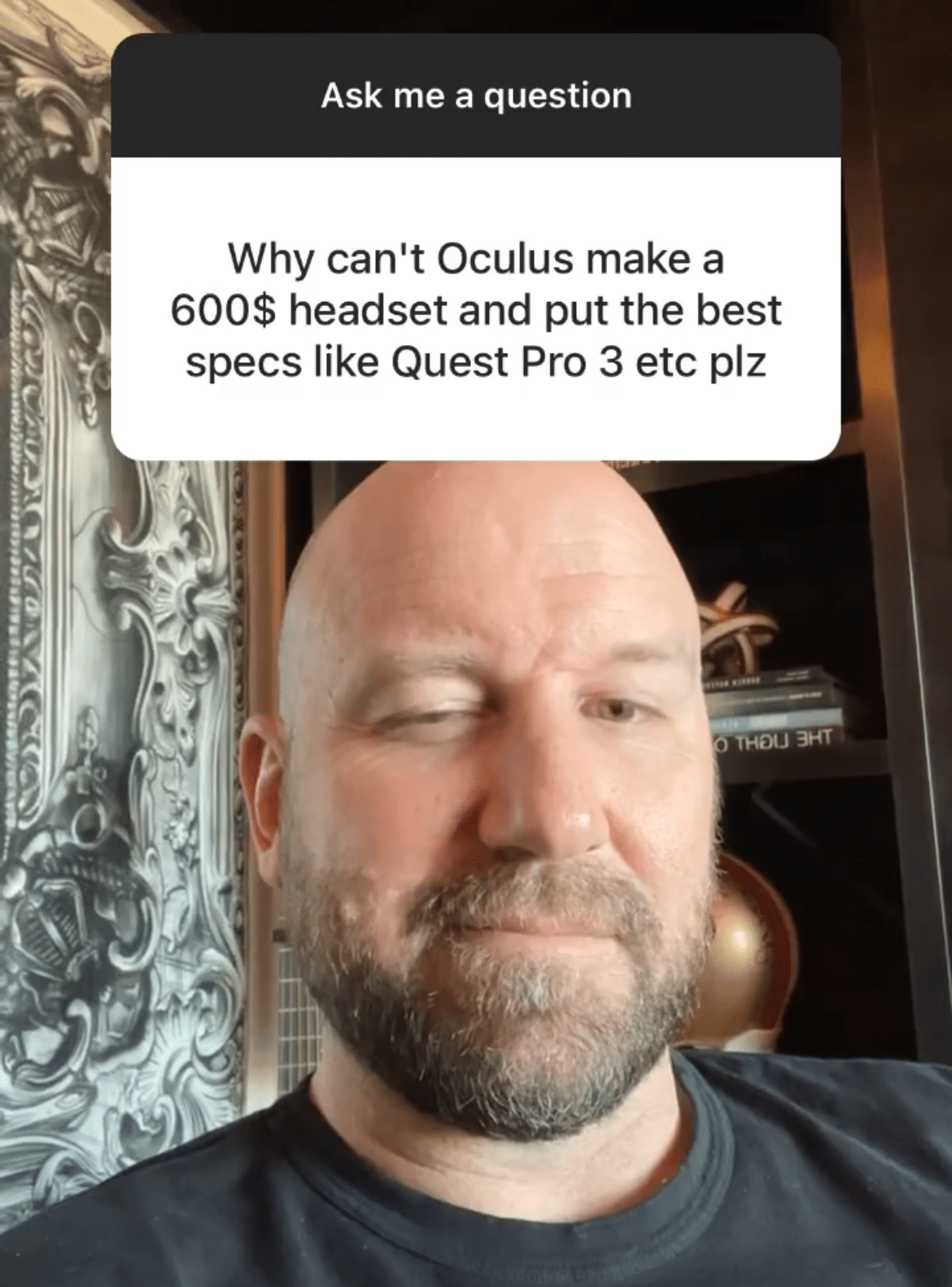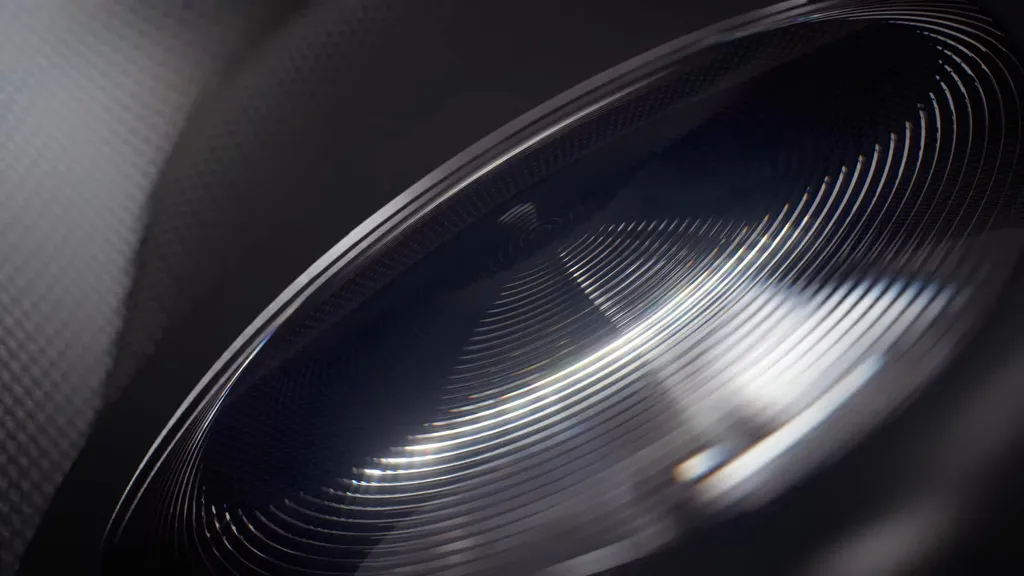Hints from Facebook higher-ups and references in Oculus firmware suggest an Oculus Quest Pro standalone VR headset is in development.
But what exactly is Quest Pro? What new features and improvements will it have compared with the current Oculus Quest 2? No specific details are certain yet, but here’s what we know so far:
Quest Pro Is A Thing, But Not Launching This Year
The first indication of “Quest Pro” came in a February Instagram ask-me-anything (AMA) session hosted by VP Facebook Reality Labs Andrew Bosworth.
One questioner asked Bosworth: “Why can’t Oculus make a 600$ headset and put the best specs like Quest Pro 3 etc plz.”
He replied “Quest Pro, huh… Interesting…” and winked at the camera.

By April, Bosworth’s stance on “Quest Pro” became more solid. In a public conversation with “Consulting CTO” John Carmack, Bosworth remarked:
“People are also asking about the Quest 3, which doesn’t exist yet, and everyone who is listening to us who is a reporter there isn’t a Quest 3, there’s only a Quest 2, but I did hint at an AMA earlier this year about Quest Pro because we do have a lot of things in development where we want to introduce new functionality to the headset along the kinds that people theorize that we would want to introduce, and that’s a little ways off still.It’s still not gonna happen this year.
For those who are curious, Quest 2 is going to be in the market for a while – for a long while, and it’s gonna be, you know, I think the best bet for the most accessible way to get into VR and have a great experience.“
This month, Reddit user Reggy04 found references to “Quest Pro” in the public Oculus firmware. But as of April, Quest Pro was “a little ways off” and not happening this year. Perhaps Quest Pro could come in 2022? We don’t know, and there’s a lot going on that could affect the plans of a company trying to ship a hardware product with new sensors inside.
Quest Pro Might Have Face & Eye Tracking
Bosworth’s answer mentioned a desire to “introduce new functionality”. In March, Facebook CEO Mark Zuckerberg described face & eye tracking as his most wanted feature for future Oculus headsets:
“One of the things I’m really excited about for future versions is getting eye tracking and face tracking in, because if you’re really excited about social presence you want to make sure the device has all the sensors to really kind of animate realistic avatars so you can communicate well.“
“On the VR side, I think the biggest things that we’re very focused on now are: how do you pack more sensors, to create a better social experience, into the device? To run each sensor requires more CPU power and that generates more heat and creates all these different issues.
In June, YouTuber Basti564 found references to eye & face tracking services in the public Oculus Quest firmware. This month, Reddit user Reggy04 found references to eye & face tracking calibration steps. While this doesn’t confirm Quest Pro will have these features, it seems to be a strong hint, given Zuckerberg’s comments.
Eye tracking and face tracking could make multiplayer & social apps more realistic. Eye tracking also has other uses, such as improving VR throwing mechanics through the app understanding what you’re aiming at.
Quest Pro Might Have New Lenses
Android Central said in June it viewed a note from Ming-Chi Kuo claiming Facebook & Sony have ordered high quantities of new, more expensive VR lenses for 2022. Kuo is a TF International Securities analyst mostly known for sometimes predicting Apple products & moves over a year in advance.
Current VR lenses have a field of view roughly around 100 degrees wide. New lenses could mean Quest Pro has a wider field of view, area of clarity, or both. In an Instagram AMA back in March, Bosworth said he likes the idea of a taller field of view, which he claimed could be more impactful than wider.
Android Central’s headline names the headset as ‘Oculus Quest 3’, but the article notes the source isn’t actually claiming that.
Quest Pro Might Have Lens Depth Adjustment
Reggy04 also found in the Oculus firmware references to lens depth adjustment.
PRESS AND HOLD THE DEPTH BUTTON AND MOVE THE HEADSET CLOSER OR FURTHER AWAY FROM YOUR FACE. THE LENSES SHOULD BE CLOSE TO YOUR EYES, BUT NOT CAUSE DISCOMFORT.
Already present in headsets like Valve Index, lens depth adjustment allows you to move the lenses closer to, or away further, from your eyes. Closer results in a wider field of view, but might be less comfortable.
Note that lens depth adjustment is a different thing from precise lens separation adjustment. Lens separation adjustment refers to changing the distance between the lenses of a VR headset and it is a feature on the original Rift and Quest as well as on the HTC Vive and Valve Index. At the time of this writing, there’s no evidence either way about whether Quest Pro will have precise lens separation adjustment.
Quest Pro Probably Won’t Be Varifocal
All VR headsets on the market today are fixed focus. Each eye is given a separate image, but the images are focused at a fixed distance from the lenses. This means that your eyes point (verge) toward the virtual distance to the object you’re looking at, but focus (accommodate) to the fixed focal length. This is called the vergence-accommodation conflict. It may cause eye strain and headaches and can also make close-up objects look blurry.
At Facebook’s annual F8 conference in 2018, the company showed off “Half-Dome”, a prototype variable focus (varifocal) headset using physical actuators to move the position of the displays relative to the lenses. In late 2019 Facebook showed a compact version called Half-Dome 2 and a version with liquid crystal lens layers instead of moving parts called Half-Dome 3.
It may seem like Quest Pro would be the ideal product to introduce this technology, but when asked about the idea in the same February AMA session where he hinted at Quest Pro, Bosworth replied:
“Half-Dome is a varifocal headset, which means the optics move to help us solve vergence-accommodation so you can focus on near objects. But building something like that has fragility, cost, weight concerns, which we haven’t found a way to balance yet. But it is still something we’re looking at.”
Carmack Thinks Quest Pro Won’t Sell As Well
In that same public conversation Bosworth signaled Quest Pro not coming this year, consulting CTO John Carmack gave his view on the prospective product:
“I’m happy to have some Pro version that’s going exploring every sensor in the kitchen sink. I just think that you’ll wind up with 1/10th of the users on there and we should be about kind of maximizing the user base.“
What processor will Quest Pro use?
Like all standalone VR headsets shipped outside China, we’d expect Quest Pro to use a Qualcomm Snapdragon chip. Quest 2 uses Snapdragon XR2, a variant of Snapdragon 865 from early 2020.
Snapdragon 865+ launched in late 2020 as a higher clocked but more expensive model. Early this year a further improved model, Snapdragon 870, shipped with an even higher clocked Prime CPU core.
A true successor, Snapdragon 888, also launched early this year. Qualcomm claims the new graphics processing unit (GPU) is 35% more powerful, but there was no announcement of an XR-focused variant or mention of VR.
Of course, XR2 could still be used but clocked higher. The primary CPU cores in Quest 2 are actually underclocked. A more advanced cooling system could allow for significant improvement in CPU, and perhaps even GPU overclocking. And since it’s not shipping this year, Quest Pro could use a chip yet to be announced.
When will Quest Pro be announced and when will it be released?
Other than noting it isn’t launching this year, Facebook hasn’t dropped any hints as to when Quest Pro might be announced or released. The company hosts an annual VR & AR conference in fall called Connect where products like Oculus Go and Oculus Quest were first announced.
This year Facebook Connect takes place October 28. There are no rumors as to what will be announced, but if Facebook does plan to reveal Quest Pro this year Connect would likely be the venue.


























